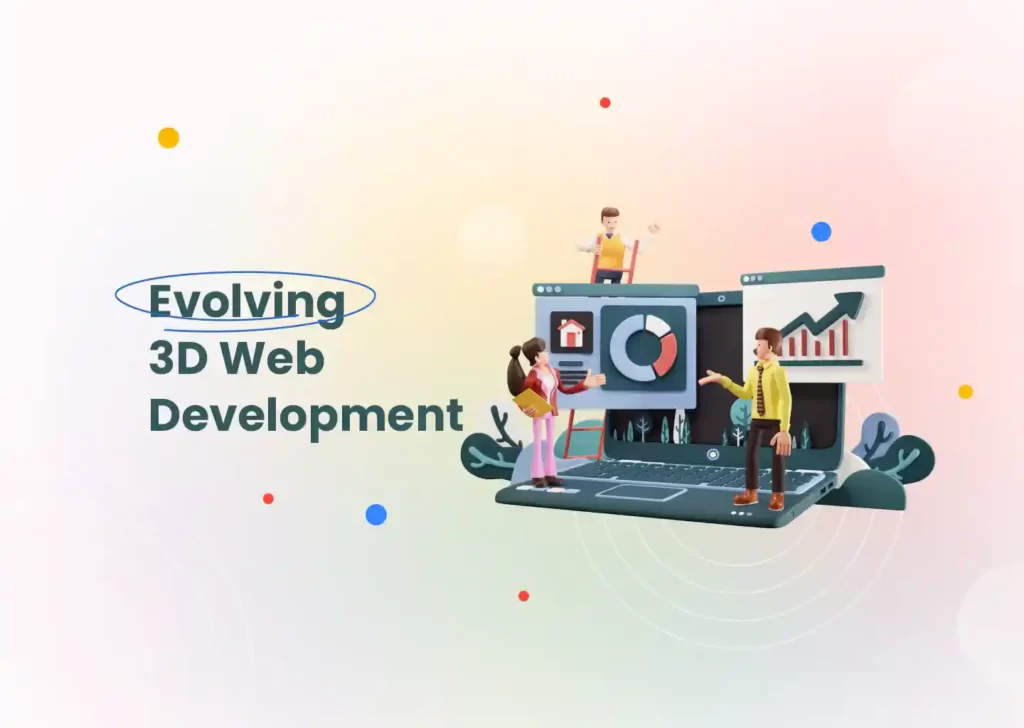In today’s fast-paced digital world, websites are no longer just flat, 2D spaces. Welcome to the era of 3D web development, where websites pop, spin, and draw users into interactive three-dimensional experiences. As you scroll through your favorite sites, have you ever paused and wondered how these intricate 3D visuals come to life on your screen? Or perhaps, as a business owner, you’re mulling over how to leverage these evolving 3D web development trends to stand out in the crowded digital marketplace?
Let’s get real: the digital scene is bustling, and to make an impression, websites now need that extra ‘oomph’! Enter the world of 3D web development. But with advancements coming in left and right, you might feel overwhelmed. What’s WebGL, and why does everyone keep talking about it? How do JavaScript libraries fit into the 3D puzzle? And, most intriguingly, what’s this buzz about WebXR?
If these questions resonate with you, you’re in for a treat! In this comprehensive guide, we’ll embark on a journey from the current state of 3D web development, delving deep into the intricate tools and technologies like WebGL and Three.js, to the promising horizons of the future. We’ll demystify the technical jargon, spotlighting how these tools are changing the face of the web.
So, whether you’re a curious user, an ambitious business owner, or a budding web developer, gear up to navigate the dynamic world of 3D web development. By the end, you’ll have a clear roadmap of where 3D web tech stands today and where it’s headed tomorrow. Ready to step into the 3D realm of the web? Let’s get started!
Current State of 3D Web Development
When you deep dive into the ever-changing waves of 3D web design, it’s like watching an artist with the latest tech gadgets. Over the past ten years, 3D hasn’t just stepped onto the scene. It’s sprinted! It’s shaken up how we build websites and how people interact with them. In the grand variety of the digital age, 3D’s vibrant threads are weaving a new narrative, making the web not just functional but highly immersive.
WebGL: The Backbone of Today’s 3D Web Development
Remember when WebGL was just a fancy term? Look at it now: turning our wildest web dreams into reality. It’s not just another fancy tech term; it’s the backbone that powers those visually stunning 3D graphics you see on modern websites. Imagine wanting to portray a realistic, interactive, 3D environment in a browser. It sounds daunting. That’s where WebGL steps in, offering a seamless, browser-compatible platform to render detailed 3D graphics. There is no need for external plugins or players; WebGL integrates directly with web browsers. So, next time you’re in awe of a rotating sneaker on a shopping site or an intricate architectural model, remember WebGL is probably the unsung hero behind it.
JavaScript Libraries and 3D Modeling: The Importance of Three.js
Let’s talk about tools, especially the ones that have made 3D web development accessible, even to those not versed in hardcore 3D modeling. JavaScript libraries, particularly Three.js, are pivotal in this aspect. Think of Three.js as the bridge that connects the complex world of 3D graphics with the more familiar territory of web development. It’s essentially a set of JavaScript tools that make creating 3D content for the web considerably simpler. You know what’s cool about it? It spares our devs the nitty-gritty of WebGL, letting them flex their muscles without breaking a sweat. So, if you’re wondering about the engine running behind most of the fantastic 3D websites, Three.js might be the answer.
The Dawn of WebXR: A New Era of Immersive Web Experiences
With the groundwork of 3D web laid and gaining momentum, the next leap forward is all about immersion. Enter WebXR! It promises 3D and a virtual or augmented reality experience in web browsers. Gone are the days when you’d need hefty software downloads to experience VR or AR. With WebXR, it’s all about bringing that immersion directly to the web, making it universally accessible. Imagine shopping online, but instead of just viewing products, you’re virtually trying them on or visualizing them in your space. Or, think about online learning, where you’re transported to a virtual classroom instead of watching a video. WebXR is turning the tables! WebXR is stirring the pot for how we engage online. It feels like we’re just on the doorstep of all it offers.
Future Trends in 3D Web Development:
Looking ahead in 3D web tech, it seems WebGL will foot with some fresh tech. Meanwhile, tools like Three.js are at the forefront, making waves, and WebXR? Well, it’s pushing boundaries, taking us into deeper digital dives.
Exploring Potential Innovations: The Future of WebGL and Other 3D Rendering Technologies
3D web development is like a river, ever-flowing and adapting its course. WebGL, the hero of our tale so far, has only just begun making waves. Peering into what’s next, I sense WebGL not just growing solo but weaving magic with newer 3D marvels, setting the stage for spellbinding visuals. And in this fast-paced tech story, don’t be startled if, one day, we’re all raving about real-time ray tracing or marveling at adaptive shading. The allure of technology is its sheer unpredictability. The next big wave in 3D is gathering momentum, ready to surprise us all.
What Lies Ahead for Three.js and Other 3D Modeling Tools?
Three.js stands tall as a beacon in the world of 3D web development. Its influence and ease have paved the way for everyone, from beginners to experts, to dip their toes into 3D modeling. And as we look ahead, we can expect this powerhouse to pack in even more punch. Imagine a world where Three.js seamlessly blends with AR and VR, becoming a one-stop shop for all our 3D dreams. And as technology races forward, it won’t be too far-fetched to foresee machine learning playing a role in rendering and modeling. But it’s not just about Three.js alone. The arrival of new players and tools will ensure that 3D modeling remains ever-evolving and electrifying.
Beyond WebXR: The Next Frontier of Immersive Web Experiences
WebXR has brought the magic of virtual and augmented realities to our everyday web browsers. But the future? It’s bound to be even more immersive. We’re discussing spatial computing, were digital and physical realms merge seamlessly. Or even multi-user VR spaces where interactions aren’t confined to a singular experience. The lines between reality and virtuality might blur, offering users experiences that were once the stuff of sci-fi. Integrating sensory feedback mechanisms, like haptic feedback, could redefine “immersive” in WebXR. The journey ahead is filled with possibilities. From highly interactive 3D web conferences to virtual tourism, the next frontier of immersive web beckons with promises of unexplored territories.
Conclusion:
3D web development is buzzing with fresh ideas and shifts, evolving, and reshaping at every turn. As our exploration from the stalwart WebGL to the emerging wonders of WebXR has shown, staying abreast of the newest techniques and tools is not just recommended. It’s imperative. The efficiency and productivity gains from leveraging the most cutting-edge 3D web development tools are undeniable. The landscape is always shifting in the tech and web development world. For those in the know, both techies and businesses, there’s a treasure trove of opportunities. Think cutting-edge rendering tech or those nifty JavaScript tools. And with the lines between the digital and the tangible getting fuzzier, keeping your finger on the pulse is the ticket to spearheading the next wave of immersive online interactions.



